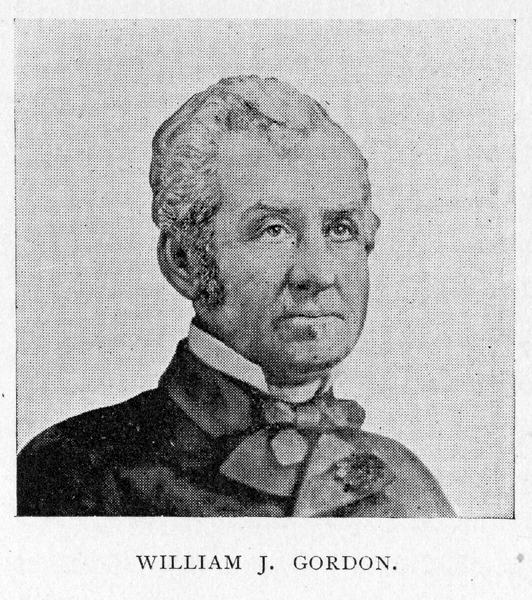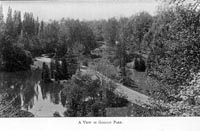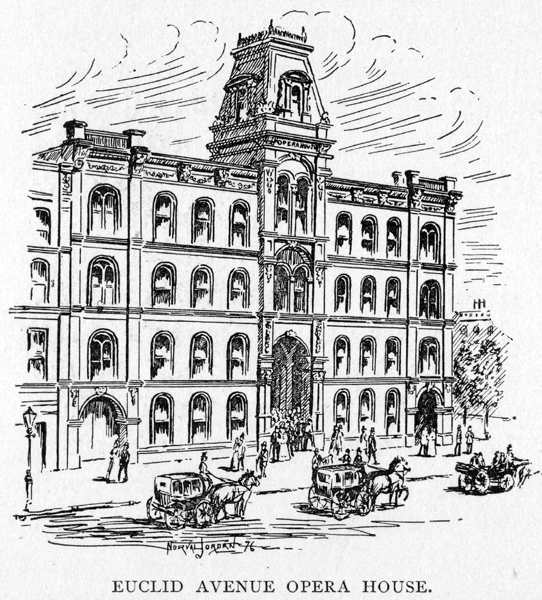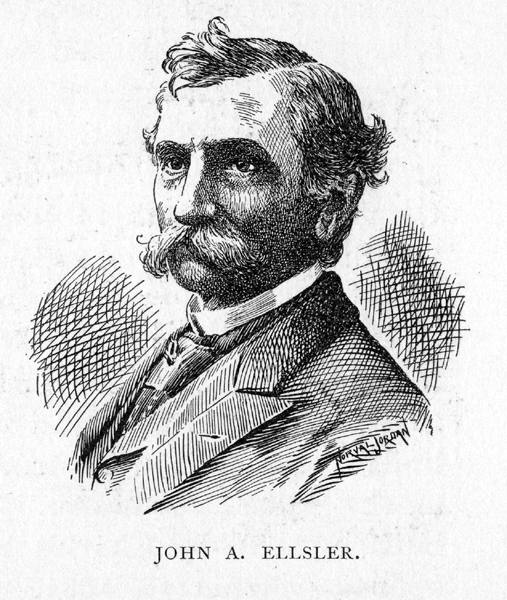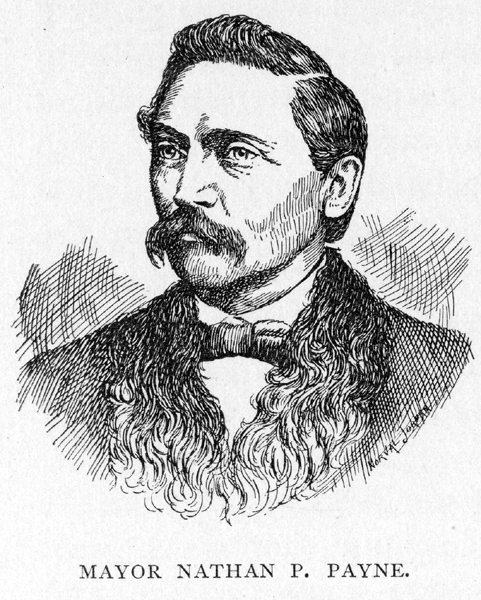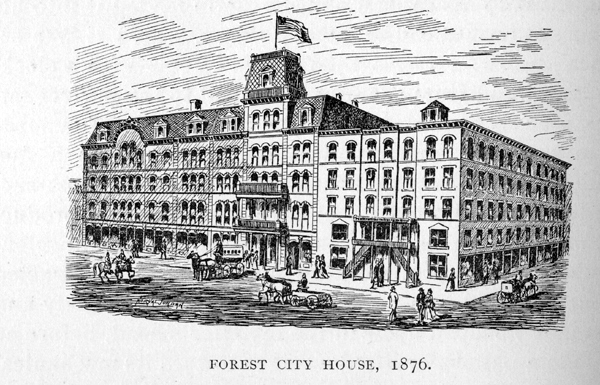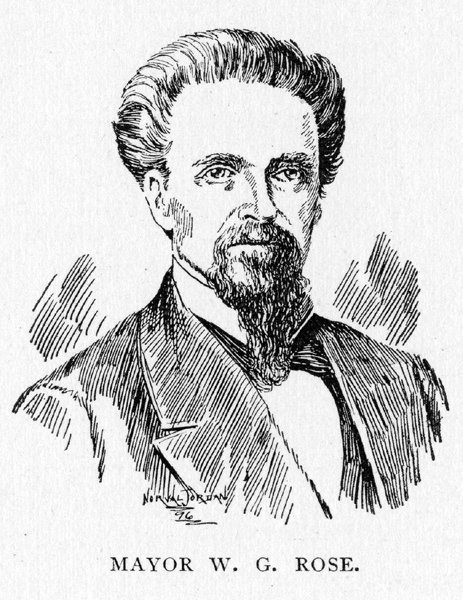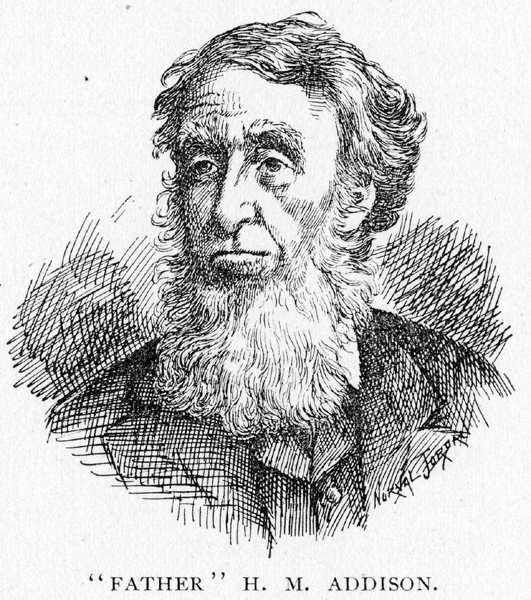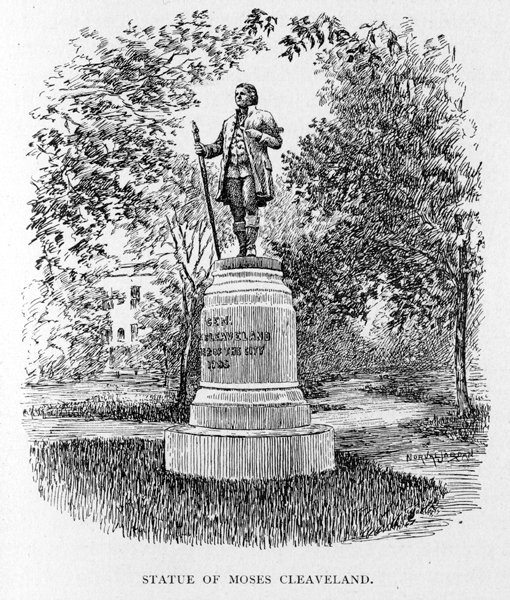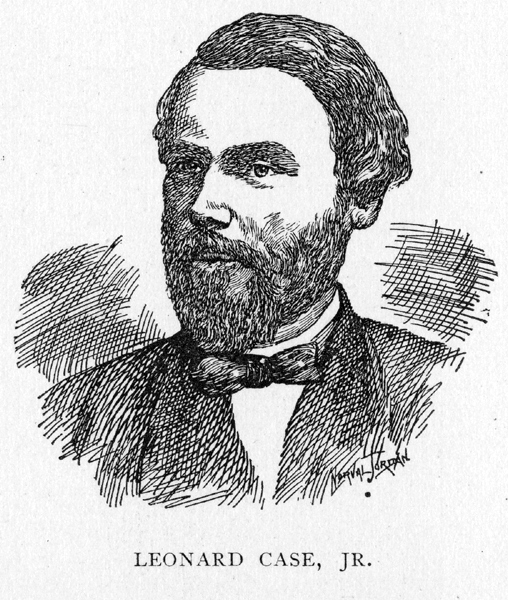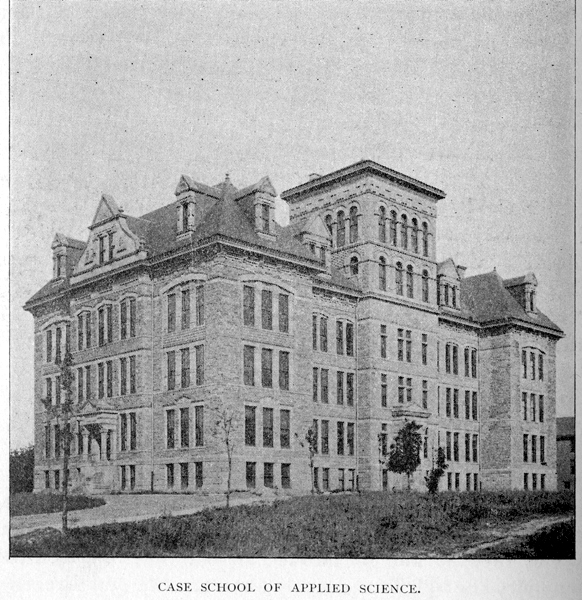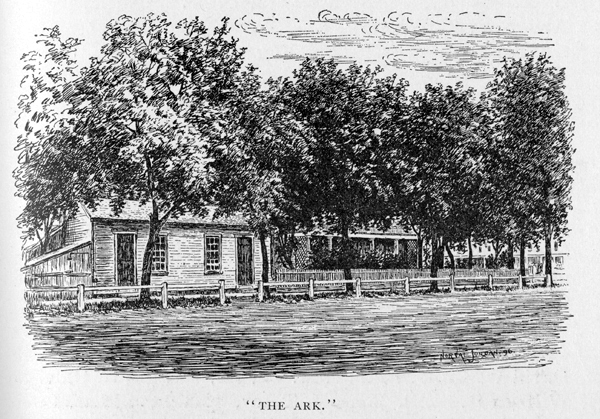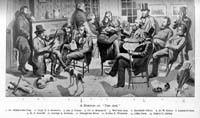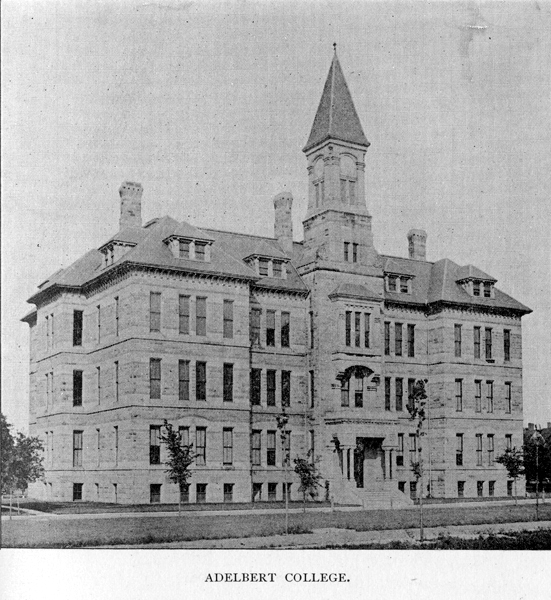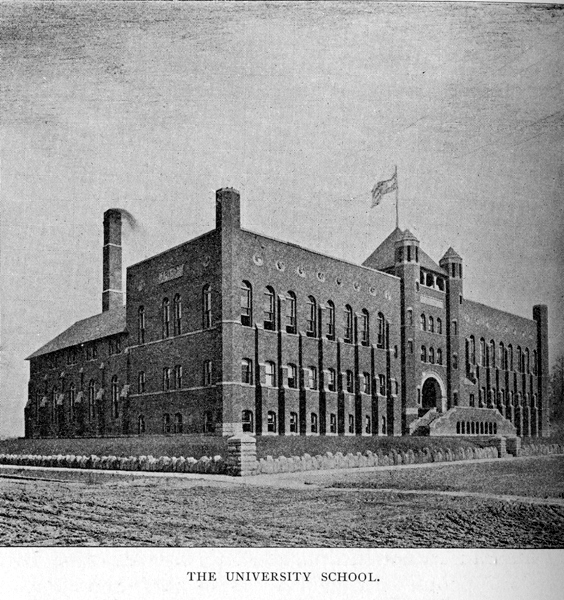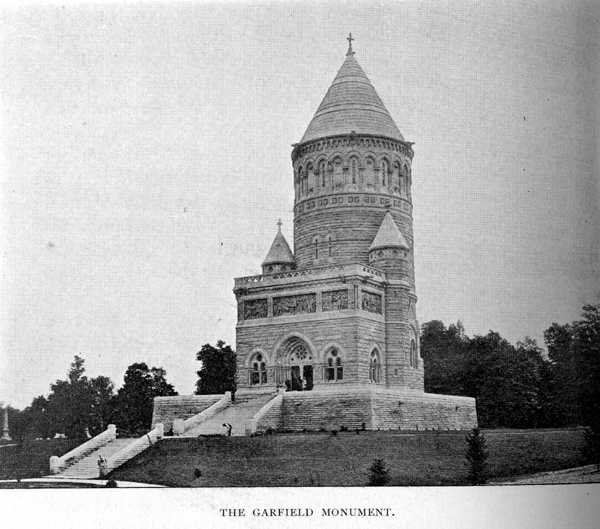|
CHAPTER XVI AN ERA OF MANY IMPROVEMENTS. The importance of creating and maintaining proper harbor facilities, was recognized in Cleveland at an early date, and the steps taken for the opening of a river channel, and protection of the lake front, in previous years, have already been recorded. The unprotected condition of the harbor, was always regarded as a source of danger, emphasized by the narrowness of the river opening, and the difficulty of making port in a time of storm. No movement toward the construction of an artificial harbor of refuge, however, was made until 1870, when the City Council adopted resolutions in favor of the construction of such work by the general government, while a petition to that effect was circulated among the citizens. An appropriation of three thousand dollars for a preliminary survey was made, and the engineers reported the cost at three million dollars�a figure so large that the committee on commerce reported adversely upon the measure. The matter was not dropped there, however, as R. T. Lyon, on January 16, 1873, offered resolutions in the Board of Trade, urging upon Congress the importance and necessity of such refuge, for the protection of vessels navigating the uncertain waters of Lake Erie. They were adopted, and a committee appointed to confer with the City Council and secure its co-operation. Hon. R. C. Parsons,222 then the national representative from this district, by strenuous efforts, and good management, persuaded the government to another survey, which work was performed in 1874 by Colonel Blount, of the United States Engineering Corps. He reported two plans�one for an anchorage of thirty acres, at a cost of five hundred thousand dollars, and the other for ninety acres, at a cost of twelve hundred thousand dollars. In the spring of 1875, Congress appropriated fifty thousand dollars for the commencement of the work, and referred the question of size and other specifications to a corps of government engineers, who reported in favor of a harbor of two hundred acres, at a cost of eighteen hundred thousand dollars. This was adopted, and when the Hon. H. B. Payne was in Congress, he secured fifty thousand dollars for a continuation of the work, and Hon. Amos Townsend had that increased by one hundred thousand. Work upon the west wing of the breakwater was commenced in the fall of 1875, and completed in 1883. The structure commences at a point seven hundred feet west of the upper end of the old river bed, and runs about due north for 3,130 feet, to a depth of 28 feet. It then turns an angle and runs nearly parallel to the shore for 4,030 feet, with a spur one hundred feet long on the north side of the lake arm, and two hundred feet from its eastern end Experience showed that still greater precautionary measures were necessary, and it was decided that the harbor to the eastward, would be sufficiently protected by extending the east pier at the mouth of the river some fourteen hundred feet. The engineer in charge, however, recommended, in May, 1884, that this plan be changed, and that an arm of the breakwater be built to the eastward, leaving an opening opposite the piers. This was approved by the department at Washington, and on August 5, 1886, Congress passed an act making the necessary appropriations for this improvement. The original plan contemplated an extension of about 3,600 feet altogether, but it was soon found that this would be insufficient, and so the plan was enlarged, and additional appropriations secured from Congress. The breakwater, under the latest plan, begins at a point on the prolongation of the lake arm of the western breakwater, and five hundred feet from it; extends eastward upon this line about 3,500 feet, then inclines toward the shore and extends 2,000 feet, in a depth of 26 feet of water, and having between its eastern end, and the curve of 14 feet depth of water, an entrance 2,300 feet wide. About 2,500 feet of this breakwater had been completed up to the early summer of 1896. It may be added, in this connection, that it is only within a few years that Cleveland has awakened to the commercial importance of its lake front. Boats grew larger under the imperative demands of trade, but there was no corresponding increase in the city�s dockage, and accordingly many large interests�the iron ore trade of the Lake Superior region, for instance�were largely diverted to other lower-lake ports. The ill effects of such desertion were plainly manifest, and steps were taken to check it. In March, 1895, the Cuddy-Mullen Company began the construction of a dock of adequate size, just east of the river, in the outer harbor, inside the breakwater. It was finished April 1, 1896. It is 623 feet long, and 210 feet wide. Adjoining it, is the dock of the Pennsylvania Company , of the same dimensions, which has just been finished. On this will be erected a passenger station and freight houses. The city has also started in to do its share toward developing the lake front. Since December, 1894, it has been extending Erie street to the water�s edge, and building piers out into the lake. Already about five hundred feet have been constructed, and it is the city� intention to make thereby large and convenient dockage for excursion steamers, and thus put the pleasures of lake travel within easy reach of the people. Ultimately, similar extensions and piers will be made, at all the down-town cross streets. A number of municipal measures of great importance occupied the attention of the city authorities and the public, during the first half of the decade from 1870 to 1880. On January 1, 1871, the penal and corrective departments of the city were divorced from the infirmary, and established in a large and well-appointed structure of their own, on Woodland avenue. The Cleveland Workhouse and House of Correction was the official title of this new institution. The building was erected at a cost of two hundred and fifty thousand dollars. The first board of directors consisted of Harvey Rice, J. H. Wade, George H. Burt, S. C. Brooks, and William Edwards. The Board of Park Commissioners also came into existence in 1871, by an ordinance passed by the City Council in August, and the following gentlemen were constituted the members thereof: A. Everett, O. A. Childs, , and J. H. Sargent. Previous to this time, the work that properly belonged to such department, had been performed by the street commissioner, and the creation of the board was the first real effort to give the city a system of public parks. Bonds to the amount of $35,000 were issued in 1872, and the first step toward the object in view was the beautifying of the Public Square. In 1874, the construction of Lake View Park was commenced, and work was soon after begun on Franklin Circle, and on the old and long-forgotten Clinton Park. The greatest step taken by Cleveland in the direction of a park system came through the munificent action of an honored and wealthy citizen. J. H. Wade223 had pur- chased a great area of land, to the north of Euclid avenue, at the extreme eastern end of the city, and by large expenditures of money had made a beautiful park, in which the skill of the landscape artist had touched the attractions of nature but to adorn. In 1882, Mr. Wade donated this park to the city, on condition that seventy-five thousand dollars should be extended in improvements. The gift was accepted, and Wade Park now stands as a perpetual monument of the foresight and generosity of Jeptha H. Wade.
A second munificent gift, of a like character, was the presentation of Gordon Park to the city by William J. Gordon,224 who was for years one of the most active and enterprising of Cleveland�s business men. In 1865, and at later peri- ods. Mr. Gordon purchased, on the lake shore, to the east of the city, several large tracts of land, and began the laying out of an extensive park. Landscape gardeners were employed, large forces of men were set at work, and there was no hesitation at any adornment or improvement because of its cost. The result was the creation of a park of 122 acres, that in attractiveness and eompleteness of artistic finish finds few equals in the country. On Mr. Gordon�s death, it was found that he had left this magnificent monument of himself as a gift to the City of Cleveland, free from burdensome conditions. The main condition was that the park should be forever maintained as such, and at all times be kept open to the public under the exclusive name of "Gordon Park." The title passed to the city on October 23, 1893. The possession of two such great breathing places, as Wade Park and Gordon Park, however, did not fill the demand certain to be made by that Greater Cleveland, which was even then looming up in the near future. In fact, these magnificent donations but stimulated the public mind, and made the people of Cleveland determined that other and notable additions should be made, that the city�s park department might equal her other claims to distinction and recognition. It was seen that the work of the future must be carried forward on a broader plan, than had been possible in the past. The agitation in favor of a comprehensive system of parks and boulevards, was carried on with commendable spirit. Several meetings of public-spirited citizens were held. A plan was formulated, and the needed legislation sought, the result being the passage, on April 5, 1893, of the so-called Park Act. This provided that a board of Park Commissioners should be formed, one of whom should be the mayor of the city, another the president of the City Council, and three appointed by the Sinking Fund trustees. In accordance therewith, the first board came into being on April 26, 1893, and consisted of Robert Blee, mayor of Cleveland; A. J. Michael, president of the Council; Charles H. Bulkley, Amos Townsend, and John F. Pankhurst. Mr. Bulkley was made president, and F. C. Bangs elected to the office of secretary. Results have already shown that these gentlemen understood, to a large degree, the needs of the situation, and the importance of the work that had been entrusted to their hands. To quote their own words: "The general plan, which they decided to be one of the best adapted for achieving the ends aimed at, had, as it principal feature, a large park on the outskirts of the city, in each of the several main sections, the same to be so located, that, in case the future should so determine, and the needs of the city so require, such outlying parks could be readily united and connected by a broad, smoothly-paved boulevard, encircling the city, thus, with the parks, forming a chain of verdure around it."225 Only the briefest mention of the labors of the commission, and the results, as already apparent, is possible here. The main features are as follows: The acquisition of the Doan Brook Valley, from Wade Park to Lake Erie, connecting Wade and Gordon parks; the creation of Edgewater Park, containing eighty-nine acres, and situated on Lake Erie, on the West Side, beginning at the foot of Waverly avenue; the purchase of Brooklyn Park, containing nearly eighty-one acres, and situated to the west of the new Brooklyn-Brighton viaduct; and creation of the South End Park, in the Newburg of the earlier days, containing one hundred and forty-five acres; the addition of thirty acres to Gordon Park, to be used as picnic grounds the creation of Ambler Parkway, containing fifty-five acres, commencing at Cedar avenue, and following the valley of Doan Brook, for a distance of one and a half miles, to the Shaker Heights; and Shaker Heights Park, containing two hundred and seventy-eight acres.226 A magnificent addition to the public park system of Cleveland was made, in 1896, when John D. Rockefeller authorized the announcement that he had quietly deeded to the city, two hundred and seventy-six acres of land, worth $270,000, for park purposes, and followed that by a cash donation of $300,000, for the purpose of completing the boulevard between Wade Park and the park lands on Shaker Heights. This announcement came as a complete surprise to the people of Cleveland. It was made by J. G. W. Cowles, president of the Chamber of Commerce, in the great mass meeting, held on July 22, 1896, in celebration of Cleveland�s Centennial birthday. Mr. Cowles explained the gift, and its conditions, in these words: "On this, Founder�s Day, of our Centennial Celebration, on behalf of the Park Commissioners, I am instructed to announce to the citizens of Cleveland, the offer made to them, not only of the gift to the city for park purposes, of the lands purchased, at a cost of $270,000, but also to replace in the treasury of the park board, the amount of $300,000, paid by said board, for Doan Brook lands, before such individual purchases were undertaken, making, in all, a gift to the City of Cleveland of two hundred and seventy-six acres, costing $600,000, upon conditions already understood and approved in part, the principal one being, that the whole amount of the cost of these lands shall be spent in improving and beautifying them, so as to make this magnificent addition to the parks of Cleveland speedily available for the use, and benefit, and delight, of all the people." The sentiment with which Mr. Cowles closed his speech found an echo in the hearts of Clevelanders, everywhere: "From this hour, in the honored and noble company of Wade and Gordon, as benefactors of their fellow citizens and fellow men, in our hearts with gratitude, and upon our lips with praise, will be the name of the giver of this princely gift, John D. Rockefeller." At a meeting of the Park Commissioners, held on August 5, 1896, there came yet another surprise, of a like welcome character, in the public announcement that Patrick Calhoun had donated to the city a strip of land, having over four hundred feet frontage on Euclid avenue, beginning at Fairmount street, and running parallel to the land given by Mr. Rockefeller, as far as Cedar avenue, thence along Doan Brook Valley, to and through Cedar Glen. This has made possible the dream of the commissioners�the construction of a circular park, on Euclid avenue, near Fairmount street, as the grand entrance to what will, eventually, be one of the most beautiful park systems in the world. In 1871, the office of city auditor was created, and Thomas Jones, Jr., elected to the position. Prior to that time, the duties belonging to such department had been performed by the city clerk, who was an officer of the City Council, and under its direct control. The new departure served as a check upon extravagance, and a safeguard against the misappropriation of funds, as the new official took the stand, and maintained it, that no warrants on the treasury could be legally drawn, unless the money to pay such warrant was "already in the treasury, and to the credit of the proper fund, to which it should be charged." The wisdom of that position has been fully proved, by the subsequent financial history of Cleveland. The growth of Cleveland, by accessions to her popula- Facing Page tion by immigration, had been steady, and the time now came when her borders were to be measurably increased, by annexations. East Cleveland had become, in all essential features, a portion of the city in fact, and it was thought, on both sides of the line, that it should become also a part in name, and in government. When the preliminary steps had been taken, the question of annexation was submitted to the voters of Cleveland, in April, 1872, and received 7,240 votes in favor, to 2,885 opposed. The East Cleveland vote upon the same question resulted in 268 in favor and 198 opposed. Henry B. Payne, J. P. Robison, and John Huntington, were appointed as commissioners for Cleveland and John E. Hurlbut, John W. Heisley, and William A. Neff for East Cleveland. It was agreed that all liabilities of the section to be annexed should be assumed by the city, with the exception of assessments for local improvements already made, that should be paid as already provided; that the annexed district should be divided into two wards; and that within eighteen months the city should expend, in those wards, not less than seventy-five thousand dollars, in extension of water pipe, fire service, and other improvements. This agreement was approved on October 29, 1872, and the two communities became one, in law. East Cleveland was hardly safe in the municipal fold, before the village of Newburg came clamoring for admission. A meeting of its citizens was held on August 4, 1873, at which resolutions were adopted, which declared that the time had come "when the necessity and future welfare of the people" imperatively demanded the benefits of village or city corporation, and that the best means of obtaining that end, was by annexation to the City of Cleveland. A committee of three, E. T. Hamilton, A. Topping, and Joseph Turney, were appointed to present a petition to the Cleveland City Council, looking to this end. John Huntington, H. H. Thorpe, and A. T. Van Tassel, were appointed to represent the Council in the matter. The question was submitted to the voters of Newburg, and carried, and before the end of the year named, Newburg constituted the Eighteenth Ward of Cleveland. The legal business of the Cuyahoga Common Please Court had so grown by 1873, that increased facilities of some character became a matter of absolute necessity. The plan suggested was the establishment of a Superior Court, on the plan of one then existing in Cincinnati, which should have jurisdiction for civil cases only, coming from the City of Cleveland, exclusive of the rest of Cuyahoga County. An act was accordingly passed by the Legislature on May 5, 1873, creating said court, to consist of three judges, who should hold office for five years. At a special election held in June, Seneca O. Griswold, James M. Jones, and Gershom M. Barber were elected such judges. The brief history of this court is thus graphically told, by one who was an honored member thereof:227 "The expectation that the two courts would be able to do the judicial work of the county, as then organized, was not realized. The business of the country, which had enjoyed an unheard-of prosperity, met with a sudden and un-looked-for check. On the 18th of September, 1873, the most extraordinary financial panic that the country had ever experienced, began. Failures of manufacturing and commercial establishments took place in every part of the country. Laborers all over the count4y were thrown out of employment, and what had never before been experienced in Cleveland, the savings banks substantially closed their doors, and even the bonds of the city sold at ruinous discount. The result upon the work of the courts was soon apparent, and in less than two years both courts were overcrowded with business, and immediate relief was required. On the 25th of March, 1875, an act was passed by the Legislature entitled �an Act to facilitate the Administration of Justice in Cuyahoga County,� by which the Superior Court was abolished, to take effect on the 1st of July following and its business transferred to the Court of Common Please, and by the same act four additional judges were added to the Court of Common Please, to be elected at the regular State election, in October of that year. At that election, two of the judges of the Superior Court, Hon. James M. Jones and Hon. G. M. Barber, were elected to seats on the bench of the Court of Common Pleas, both of whom served two successive terms in that court, and are now in active practice. Judge Seneca O. Griswold, on the termination of the Superior Court, returned to practice, and until his health failed, was recognized as one of the ablest member of the Cuyahoga County bar." The general financial difficulties, to which Judge Barber refers in the above, were the most severe that had been experienced since 1857, and were largely caused by the same combination of circumstances that brought about the panic of 1837. General speculation, excessive inflation, and the projection of far more railroads than were needed, combined with the actual shrinkage from war prices, worked together for the crash that was started on that memorable day, when Jay Cooke & Co., of Philadelphia, went down. Business everywhere received a severe check, there were failures in all directions, and from four to six years passed before the country really recovered. Cleveland, like other cities, felt the blow, but had so far advanced in wealth and manufacturing importance that the shock was but temporary. Not a bank was compelled to suspend. The most severe effects were felt upon real estate values, which wild speculation had inflated beyond all reason, and many projects for pushing the limits of the city far beyond the demands of the day, went suddenly to pieces, at the first touch of the storm. One of the leading features of 1874 was the great woman�s crusade against the liquor traffic. This phenomenal movement had its commencement in Hillsborough, O., in December, 1873, when Dr. Dio Lewis, of Boston, delivered an address on temperance, in which he sug-
gested that "the work of temperance reform might be successfully carried on by women, if they would act about it in the right manner�going to the saloon-keeper, in a spirit of Christian love, and persuading him, for the sake of humanity and his own welfare, to quit the business," When the speaker asked if the ladies present were ready to undertake the labor, scores of them arose in pledge for the undertaking. On the day following, a number of them met at the church, and after services filed out two by two, called at the nearest saloon, where prayer was offered, and then went on to other places, which were visited in a like manner. Saloon-keepers, inn-keepers, and druggists were all asked to sign the pledge and quit the business. The plan was soon followed in other places, and before long these "praying bands" were seen in all parts of the State.228 The movement reached Cleveland on March 10, 1874, when a meeting was called under the auspices of the Women�s Christian Association. Six hundred women responded, among them the leaders of thought, the most active in church work, the most cultured to be found in the city. A Temperance League was formed, with Miss Sarah Fitch as president. Pledge books were obtained, the city districted, and praying bands sent out. "In a short time," to quote from the official report of the Crusade, "over five thousand were enrolled members of the league, each one signing a pledge neither to use intoxicants nor offer them as a beverage, and to discountenance their use in every possible way; and about ten thousand names to all the other pledges." The first visit was to a saloon on the Public Square, on March 17th, by a band of twenty-two, led by Mr. W. A. Ingham. The work was carried on for weeks, with only one or two disturbances of note, which were quickly subdued by proclamation of Mayor Otis, and the efficient work of the police. To continue the above record: "During these three months of crusade work, three distilleries, eight breweries, thirty-one drug stores, thirty-five hotels, forty wholesale dealers, and one thousand one hundred saloons were visited, many of them again and again. Four hundred and fifty of these places often admitted the band for services. There were seventy out-door meetings in warehouses, etc. Mass meetings on the Sabbath, conducted by women, were held in wigwams in different wards, as well as churches and always crowded." A closed saloon on River street was converted into a home for temperance and general rescue work under the name of the River Street Friendly Inn. Other institutions of a like character were opened in various parts of the city, and some of them have found permanent work and locations, and are ranked among the most efficient of the reformatory and moral agencies of the city. The Young Ladies� Temperance League was also one of the direct results of this season of temperance labor. The most direct and permanent result of this crusade, however, came in the establishment of the Woman�s Christian Temperance Union, which was organized as the Woman�s Christian League, and incorporated under that name in 1880, making the change of appellation in 1883. This great Union has, in many ways, worked for the good of the community, in lines of temperance, and religious and benevolent labor. The holding of the nineteenth Saengerfest, in 1874, was an event which illustrated the great importance of the German element in Cleveland, and its ability to carry out any undertaking to which it was committed. A stock company was raised, and sixty thousand dollars paid in, with which a large structure was erected on Euclid avenue, between Case and Sterling avenues, with a capacity of fifteen hundred on the stage, and nine thousand in the auditorium. The week from June 22nd to 29th was given over to orchestral and vocal music of the highest character, participated in by German singing societies from all parts of the country.
The opening of the newly-erected Euclid Avenue Opera House, on September 6, 1875, was in the direction of better amusements, and provided a place of entertainment in keeping with the size and culture of modern Cleveland, which had long outgrown "Brainard�s Hall," and the old "Academy of Music," on Bank street. The movement for securing this needed dramatic temple was set on foot by John A. Ellsler, who gave his time, and so pledged his means, that when it proved to be otherwise than a financial success, he lost the accumulation of a life of devotion to his chosen profession. A retrospective glance at Cleveland, from the theatrical standpoint, will be of interest. In 1820, when yet a straggling village of five hundred souls, Cleveland was visited by its first theatrical troupe. This was managed by an actor named Blanchard, and as there wad no other suitable place, the performances, which lasted a week, were given in the ball-room of the Cleveland House, which stood where the Forest City House is now. After that, there were many performances of this nature in the ball-room, and later in the old brick courthouse on the Square. Here Shakespeare was first given in 1831. The first building, especially erected for a theatre, was at the corner of Union lane and Superior street hill. It was built by Samuel and William Cook. The theatre was on the second floor, a room about 70 by 50 feet, and was poorly equipped for its purpose. Early in the thirties, Italian Hall was guilt, on Water street, where the wholesale grocery of William Edwards & Co. now stands. It was of brick, three stories high, and the theatre was on the top floor. In 1839, Mechanics� Hall, at the corner of Prospect and Ontario streets, was fitted up as a theatre, but the enterprise was unsuccessful. The Water Street Theatre was built, in 1848, by John S. Potter. It stood on the present site of the New England House, and was a magnificent structure for the times. It had a front of sixty feet, a spacious pit, two tiers of boxes and four private boxes, and seated over a thousand people. It was destroyed by fire in 1850. Watson�s Hall was built in 1840, by J. W. Watson, on Superior street, where the Wilshire Building is now located. In 1845, Silas Brainard bought it, and changed the name to Melodeon Hall, by which title it was known until 1860, when it was called Brainard�s Hall. It was afterwards knows as Brainard�s Opera House, and the Globe Theatre; it was torn down in 1880.
The most famous playhouse in the city was the Academy of Music, on Bank street. It was built in 1852, by Charles Foster, who ran it for a short time, and then, on account of bad business, leased it to John A. Ellsler, Jr. On its boards, the most famous actors of the world appeared, and from its stock company many of to-day�s great actors were graduated. It was partly destroyed by fire on June 30, 1889, but was rebuilt, only to suffer entire destruction from the same cause, on September 8, 1892. It was again rebuilt, in a cheap way, and is now used as a variety house. Shortly after the building of the Academy of Music, P. T. Barnum started a theatre in the Kelley Block, on Superior street. It was afterwards managed by
A. Montpelier as a variety theatre, until he assumed charge of the Theatre Comique. Then it was converted into offices. The Theatre Comique was built by G. Overacher, in 1848, and was a prosperous theatre until the Academy of Music came into existence, when the competition proved disastrous. It was then run as a variety show by A. Montpelier, and after he retired was continued on the same lines by his successors. It was torn down some years ago. In 1875, John A. Ellsler, Jr., as before stated, formed a stock company, and built the Euclid Avenue Opera House, at a cost of $200,000. It was opened September 6, 1875, with Mr. Ellsler as manager, and he continued in charge until 1878, when poor business compelled him to abandon management, and the house, It was then sold at sheriff�s sale, to Marcus A. Hanna, its present owner. October 24, 1892, this theatre was destroyed by fire, but it was immediately rebuilt by Mr. Hanna, on a grander scale than before, and was reopened on September 11, 1893. The Park Theatre, built by Henry Wick & Co., and managed by Augustus F. Hartz, was dedicated October 22, 1883. Fire destroyed it January 5, 1884. It was rebuilt and reopened September 6, 1886. It is now known as the Lyceum Theatre. The Cleveland Theatre was built in 1885, by Charles H. Bulkley, and was formally opened October 19, 1885. It was destroyed by fire December 7, 1891, but was rebuilt at once, and reopened March 21, 1892. The Star Theatre was built by Waldemar Otis, and was opened September 12, 1887. It was first known as the Columbia Theatre, but took the present title in 1889. The People�s Theatre was once a skating rink, but was opened as a theatre January 26, 1885. It was made over, for a business block in 1887. Of the minor places of amusement, Case Hall, now turned into offices, was the most famous, and all the great musicians of the past thirty years appeared there. Also there are the Y. M. C. A. Hall, Music Hall, and various smaller halls used for concerts and the like. The National Centennial year, 1876, was ushered in with a welcome, the like of which the city had never before witnessed, and in which all the people participated. An official invitation had been issued to the public at large, by the mayor and City Council, to attend an informal midnight reception at the City Hall, which was elaborately decorated for the occasion. A clear sky, and weather of almost June warmth, invited to outdoor exercise, and at an early hour of the evening the streets were filled with people. As eleven o�clock approached, a myriad of lights began to show around the Public Square, and when the clock struck, all the lower part of the city burst into a blaze of illumination. The signal was taken up in all directions, and street after street, clear out to the suburbs, added to the brightness and enthusiastic effect of the scene. On the stroke of twelve, the steam whistles all over the city, broke into one vast chorus of echoing notes. A great cauldron of oil on the Public Square was set ablaze, and the deep boom of the guns was heard. Before the echo died away, a perfect tornado of sound swept in from all quarters, and made the very foundations of the earth seem to shake. The alarm of the fire bells cleft the air with sudden sound, and a dozen church towers gave answer, while the hoarse voices of the steam monsters, the banging of firearms, the popping of firecrackers, and the shouts of thousands of excited people , were added to the chorus, while every now and then the deep boom of the cannon came in as a heavy accompaniment. The main events of the year thus patriotically ushered in, can be briefly noted. At daybreak, on July 4th, the great steel flagstaff229 on the Public Square, erected by private generosity, was formally delivered to the city, through Mayor N. P. Payne, and other exercises of a pa-
triotic character marked the hundredth anniversary of the nation�s independence. Other features of the year were the opening of Riverside Cemetery, already described; and a Police Life and Health Fund, created by act of the Legislature to provide pensions for disabled police officer, or aid for the families of those fatally injured in the discharge of duty.
The year also saw the solution of the problem of electric lighting, by Charles F. Brush, a Clevelander, who, in this year, perfected the dynamo that is the foundation of the lighting system known by his name the world over. Charles F. Brush230 and his work deserve more than a passing mention, as this great invention gave him immediate rank among the great inventors of the age. He had commenced life in Cleveland as an analytical chemist, in 1872, when the Cleveland Telegraph Supply & Manufacturing Company was formed, and being called upon by that organization to do some special scientific work, became deeply interested in the subject of electricity. An arrangement of mutual assistance and cooperation was made between the company and himself, and he set to work to solve the question of electrical lighting. Within a few weeks, he completed his first attempt, performing the greater part of the mechanical labor with his own hands. Before exhibiting it to his associates, he look it out to his father�s farm, east of the city, and tested it with a horse-power, used in the farm labor. Having seen it work to his satisfaction, he again loaded it into his buggy, and took it to the Supply works, where it was set up in a corner. It was then put in circuit with a clock-work lamp, and from the first it worked to the perfect satisfaction of all concerned, and for many years afterwards was in constant and practical operation. It is a fact worthy of note, that the Brush machine, of its most successful pattern, showed no change from this first production in the principles of construction or in general scientific plans. This first working machine was constructed without a model, after the plan which had definitely and permanently shaped itself in the inventor�s head, before he had made a pattern or lifted a finger toward its mechanical execution. The first machine gave one light of about three hundred candle. power. Mr. Brush supplemented the machine with the invention of an accompanying lamp, which was also a marvel of completeness, for the work for which it was intended. Though the commercial enterprise of the Brush Electric Company (which appeared as successor of the organization above named), under the efficient management of George W. Stockly, the new inven-
tion was pushed with great energy, and an immense and wonderfully successful business built up. While the total sales of 1877 reached but thirty-five thousand dollars, those of 1882 had reached over two million.
At the very close of this Centennial year, which had been ushered in amid such rejoicings, there occurred, so near to Cleveland as to become a part of its record, one of the most terrible railroad accidents every recorded. On the evening of Friday, December 29, 1876, in the midst of a fierce snow and wind storm, a heavily laden passenger train on the Lake Shore & Michigan Southern Railroad went down with the bridge, it was crossing, into the ravine of the Ashtabula River, and a hundred and more passengers met instant death, while scores of others were injured. The train was late, and two engines were hardly able to drag it though the blinding storm. It consisted of two express cars, two baggage cars, two day passenger coaches, a smoking car, a drawing-room car, and three sleepers. The passenger cars were all filled with travelers, most of whom were going to or returning from, events connected with the happy holiday season. The crash came without warning, and in an instant the bridge and train lay a ruin, a the bed of the ice gorge below, and a moment later fire broke forth, to complete the work of death. It was a scene that no pen can describe, and there is no need for the re-telling. The citizens and firemen of Ashtabula did all that lay in their power. A relief train was sent as soon as possible from Cleveland. The railroad authorities worked with herculean powers for the relief of the suffering, and the preservation of the remains of the dead. Every house, and office, and saloon, at Ashtabula Station became a hospital for the night It was an awful night, the cold and storm adding their terrors to those of fire and suffering and death.231 The military spirit of Cleveland, seems to have experienced a sudden revival in 1877, if we may judge from the practical results. In that year, the Fifteenth Regiment Ohio National Guard was organized, largely through the efforts of Colonel A. T. Brinsmade, then an aid on the staff of Governor Hayes. It was at first composed of the Brooklyn Blues, the Emmett Guards, the Veteran Guards, the Forest City Guards, the Townsend Guards, and the Buckeye Guards. The regiment was organized in June, with the following officers: Colonel, A. T. Brinsmade; Lieutenant-Colonel, George A. McKay; Major, Henry Richardson; Surgeon, John F. Gibson, M. D.; Assistant-Surgeon, R. W. Stannard, M. D.; Adjutant, George B. Huston; Quartermaster, George D. Scott; Chaplain, Rev. James A. Bolles. The regiment was soon increased to ten companies, by the accession of the Chagrin Falls Guards, of Chagrin Falls; the Hart Guards, of Elyria; and Berea Guards, of Berea, and the Washington Guards, of Cleveland. The Cleveland Gatling-Gun Battery was also organized in 1877, the citizens of the city having provided two gatling-guns for their use. The first officers were: Captain, W. F. Goodspeed; Lieutenant, Frank Wilson; Orderly Sergeant, Thomas Goodwillie; Quartermaster-Sergeant, J. Ford Evans. All of the members were well-known gentlemen,
and the aim, from the beginning, has been to keep the battery up to a high standing, in both a military and social way. Still another military organization that saw a beginning in 1877, was the First Cleveland Troop, which was created on September 10. A meeting of a number of citizens was held in Weisgerber�s Hall on that date, and was presided over by Colonel W. H. Harris. It was decided that a cavalry company should be formed, and the organization was perfected on October 10th, with the election of : Captain, W. H. Harris; First-Lieutenant, E. S. Mayer; Second Lieutenant, George A. Garrettson; First Sergeant, Charles D. Gaylor; Surgeon, Frank Wells, M. D. There were forty original members, and the preamble to the constitution declared that the troop was created so that the members might "perfect themselves in horsemanship, in the use of arms, and in military exercise." In 1878, the troop took possession of its own fine brick armory, on Euclid avenue, near Case avenue, and in 1884 removed to more commodious quarters, on Wilson avenue. It long since took high rank among the leading independent military organizations of the country. It was thought, in the summer of 1877, that there would be immediate need not only of the newly organized Fifteenth Regiment, but of such other military assistance as could be secured. The great railroad strike of that year will be long remembered, not only for the actual damage that resulted, but also because of the greater dangers that were threatened. The terrible destruction of railroad property in Pittsburg, by the mob that took advantage of the strike disturbances, caused dismay in other cities to which the strike had extended. It reached Cleveland on July 22nd, when five hundred men, in the employ of the Lake Shore & Michigan Southern Railway Company, ceased work, and by their absence, left the business of the road almost at a standstill. Travel and transportation were for the time paralyzed, thousands of men were thrown out of employment, and a state of anxiety as to what might come next prevailed. The strikers themselves were quiet and law- abiding, and their leaders counseled them to prevent all acts of violence, so far as lay within their power, but there was danger that the lawless and criminal classes might find their opportunity for outbreak, in the public excitement, and the unrest of labor.
The discretion and wisdom of Mayor William G. Rose, and his associates in the city government were brought into play in a most admirable manner. Counseling peace and moderation, upon the part of all, sympathizing with the railroad men in such demands as were just, and at the same time showing them that violence would not be tolerated; preparing for the worst, and making arrangement to meet it with vigor; they carried the city through two weeks of danger, without the striking of a blow, or a dollars damage to public property. The authorities made no parade of their preparation; not a drum tap was heard, nor a body of troops seen in the streets. Yet, in police stations, in armories and elsewhere, armed police, militia, independent companies, and volunteer veterans of the war, lay for days upon their arms, ready to crush at one blow the first sign of violence. When the railroads and their men came to terms, all things moved on as before, and Cleveland had no reason for regret, and no bill of damages to pay. A more attractive picture is that which presents itself in the closing days of 1878, when the people of te entire city turned out to celebrate the completion of that great stone structure which bound the East Side and the West Side in new bonds of union. The two sections, that at one time faced each other across the valley with such bitter rivalry, had become one in interest, and lived in the greatest harmony, and with this new viaduct carrying
travel and traffic across the flats of the Cuyahoga, the one barrier against still closer intercourse was removed. Naturally, better means of communication between the two sides of the river had been discussed from the days of the great bridge war, and bridge after bridge had been constructed, only to prove that the toilsome ascent and descent of the hills was still an unpleasant feature of travel between the east and the west. In his annual message of 1870, Mayor Stephen Buhrer urged the construction of a high level bridge, and again referred to it in his communication to the City Council in the year succeeding. In response to these suggestions, the Council passed a resolution appointing a committee to report upon the question of such bridge. A favorable report was made, but a great deal of public opposition was developed against a bridge of the character then proposed. Accordingly, on January 30, 1872, John Huntington introduced in the City Council a resolution for the appointment of a special committee, to take into consideration the construction of a bridge across the river, at Superior street, and to confer with the Cleveland, Columbus, Cincinnati & Indianapolis Railway Company, as to the advisability of sinking their track below grade. The resolution was adopted, and entrusted to a committee consisting of Mayor F. W. Pelton, City Engineer C. H. Strong, John Hnntington, and H. W. Leutkemeyer. On March 19, these gentlemen presented their findings to the City Council, in an extended report. They found that two routes were practicable, as follows: From the Atwater Building, Superior street, to the intersection of Pearl and Franklin streets, which would require a continuous high bridge between the points named. Second, from the intersection of Superior and Union streets, to the intersection of Pearl and Detroit streets. They submitted figures showing the cost of each route, and declared that, in their opinion, the Superior and Pearl street route possessed advantages not to be found in any other. They urged its adoption, and suggested that the City Council obtain from the Legislature such authority as the situation made necessary. The aid of the General Assembly, therefore, was invoked, and a law was passed authorizing the city to issue bonds to the amount of one million one hundred thousand dollars, for the construction of the proposed viaduct. The question was duly submitted to the voters and was carried by a majority of 5,451. A contract for the masonry on the West Side was let, when an injunction was obtained by parties opposed to the measure, which tied it up almost completely until 1873. Progress was made slowly, and on May 4, 1876, a special election was held, which decided affirmatively these two questions: Whether toll should be charged, and whether more bonds should be issued for the completion of the work. Legislation was finally secured abrogating the toll decision, and making it a free bridge. When the great and needed viaduct was turned over to the city authorities, on December 27, 1878, it had been four and a half years in building, and had cost $2,170,000. The character of the structure can be best understood from the following figures, given by B. F. Morse, who succeeded Mr. Strong as city civil engineer, and who had charge of the enterprise during the greater portion of the time: The Viaduct, from Water street to its intersection with Pearl and Detroit streets, is 3,211 feet in length, and exclusive of drawbridge is 64 feet in width, with a roadway 42 feet wide and sidewalks 11 feet in width. The drawbridge is 332 feet in length, 46 feet in width, with roadway 32 feet wide and sidewalks 7 feet wide. The height of the roadway of the draw above low water mark in the river is 70 feet. There are ten stone arches on the west side of the river, of which eight are 83 feet and two are 97 1/2 feet span. The length of the roadway supported by stone arches is 1,382 feet. The average height of arches above the surface of the ground is 54 feet, and above the pile foundations 76 feet. The total number of piles driven for foundations of arches and river
piles, is 7,279, and, if laid lengthwise, would extend 277,092 feet, or a fraction over 52 miles. There are 80,508 perches of solid masonry in the Viaduct, and 15,500 cubic yards of gravel filling. The approximate weight of materials resting on the pile foundations of the ten arches is 140,000 tons; on the foundation for iron work 12,500 tons, and on the pier that supports the draw, 610 tons. All Cleveland made holiday on December 28, 1878, when the long-needed and long-wished-for structure was dedicated to the public use. A federal salute at daybreak, from the Cleveland Light Artillery, opened the exercises of the day. At 10.30 a. m. there was a great parade, by the military, uniformed societies, the fire department, and citizens generally, and at 12.30 exercises of a fitting nature were conducted in the old Tabernacle on Ontario street. Hon. B. R. Beavis presided. Prayer was offered by Dr. Charles S. Pomeroy, and an extended address, covering the history of the structure, delivered by William G. Rose, mayor of Cleveland. An address was also delivered by Hon. R. C. Parsons, succeeded by remarks from Hon. F. J. Dickman, William W. Armstrong, Hon. R. M Bishop, Governor of Ohio; Governor Mathews, of West Virginia, and others. A banquet at the Wedd3ll House followed in the evening, Hon. Amos Townsend presiding. A number of eloquent speeches were made by prominent Clevelanders, and by distinguished guests from elsewhere. On the day following, the great bridge was opened for the use of the public, and the East Side and West Side became one in fact, as they had before been in civil and governmental matters. It was in 1879 that the first steps were taken toward the formation of an organization that has been second only to the Western Reserve Historical Society, in the value of its labors, and in whose publications has been preserved a great amount of valuable historical information, that otherwise would have been lost. This was the Early Settlers� Association of Cuyahoga County from whose Annals I have so freely quoted, in the pages that have gone before. Through the indefatigable labors of Harvey Rice, and his associates, the story of Early Cleveland has been gleaned in a wealth of detail seldom obtained in matters of that character, and preserved for use and reference through all time.
The idea of such organization found origin in the mind of H. M. Addison, a well-known pioneer, whose interest in all matters of the past has been great and long-continued. In the fall of 1879, he published a number of articles in the daily press of Cleveland, in relation to this matter. His idea, he has since explained,232 was the cultivation of "an intimate acquaintance with each other," and the perpetuation of "the kindly feelings for which pioneer life was proverbial, and to secure the preservation of much of the unwritten history of our county and its vicinity." To give effect to this idea, Mr. Addison wrote and circulated a call for a public meeting of such as might be interested.233 The response was general, and on November 19, 1879, a large number of
early settlers gathered at the rooms of the Probate Court. An organization was effected by the selection of John W. Allen as chairman, and H. M. Addison, secretary. It was decided that a society should be formed, under the name above given, and a constitution was adopted which declared that the membership should consist of such persons as had resided within the county for forty years, and which stated the reason for existence in these works: "The object of the association shall be to meet in convention annually, with the view of bringing its members into more intimate social relations, and collecting all such interesting facts, incidents, relics and personal reminiscences, relative to the early history and settlement of the city and county, as may be regarded of permanent value and transferring the same to the Western Reserve Historical Society, for preservation and for the benefit of the present and future generations." The first permanent officers were then elected, as follows: President, Harvey Rice; Vice-President, Sherlock J. Andrews, John W. Allen; Secretary and Treasurer, George . Dodge; Executive Committee, R. T. Lyon, Thomas Jones, Jr., S. S. Coe, W. J. Warner, David L. Wightman. The first annual convention of the association, was held at the Euclid Street Presbyterian Church, on May 20, 1880. From that time until the present these annual gatherings have been held, each a season of great pleasure and profit to all who were permitted to be present. Mr. Rice held the office of president, by successive elections, until his death, when he was succeeded, in 1892, by the election of Richard D. Parson, who has been continued in the office until the present time. It is due to the efforts of this association that Cleveland possesses the bronze memorial of the founder of the city, that stands on the southwestern quarter of the Public Square. In a historical address, delivered by Samuel E. Adams, at the first annual convention, he suggested that the association "would do a noble and commendable act were it to inaugurate a project for the erection, in Lake View Park, of a monument crowned with a statue of General Cleaveland, commemorative of his having founded our beautiful city." A resolution favoring this suggestion was adopted at this gathering.
At the annual meeting of 1883, a resolution was also adopted to the effect that the association "proceed to raise a fund for the purpose of erecting, at some suitable point within the City of Cleveland, a life-size statue, in marble or bronze, of General Moses Cleaveland," and also providing for the selection of a committee of three to take the matter in hand. The following gentlemen were appointed; R. P. Spalding, Dudley Baldwin, and Bolivar Butts. The work was pushed as rapidly as circumstances would
permit, and the completed monument was ready for unveiling on the afternoon of July 23, 1888. (The 22nd, or anniversary of Cleaveland�s landing at the Cuyahoga, fell upon the Sabbath.) The members of the association were escorted from Music Hall, where the annual convention had been in session, to the Public Square, by the Cleveland Grays. The exercises were opened by A. J. Williams, chairman of the executive committee, who explained that President Rice would not be present, because of sickness. He then gave the signal, and the flag draping the statue was removed, amid the admiring plaudits of the gathering. An address prepared by the president, was then read by M. Williams, the closing words of which contained a formal presentation of the monument to the city. A graceful response was made by Mayor B. D. Babcock. "As mayor of the City of Cleveland," said he, in conclusion, "in behalf of the people, I accept from you this beautiful and appropriate monument. Here, in the midst of these beautiful surroundings, upon these grounds dedicated forever to the public use, may it ever stand upon its firm foundation, to perpetuate the name and memory of Moses Cleaveland." The address of the day was delivered in Music Hall, a little later, by Samuel E. Adams. An ode, "Our City�s Birthday," composed by Mr. Rice,234 was sung, and after other brief exercises, the proceedings came to a close.235 The monument consists of a circular pedestal of polished granite, seven feet high, surmounted by a bronze statue seven feet and ten inches in height. It was cast in one piece, weighs 1,450 pounds, and is a life-like re- production of General Cleaveland, dressed in the fashion of his day, with a staff in his right hand and an old-fashioned compass clasped in the elbow of his left arm. The total cost was $4,378.
The death of the younger Leonard Case, and the public announcement of his benefactions, comprised two of the most important events in Cleveland, in the year 1880. In an earlier portion of this record, we have noted the arrival of the elder Leonard Case in Cleveland his connection with the city�s first bank, and the part he took in the city�s welfare, as a busy and shrewd man of business. He early saw that Cleveland was destined to become a place of importance, and made large purchases of land, in what was then the suburbs, and which the rapid growth of the city soon made of enormous value. His elder son, William Case, took an active part in public affairs, filling at one time the office of mayor. The son Leonard was a student and semi-recluse, finding his life and companionship in books, science, literary labors, and mathematics. Left the sole heir of a large estate, he regarded it as a trust, and when he suddenly died, on January 6, 1880, it was found that he had made his beloved home-city the heir to a princely sum, the use and direction of which had been carefully pre-arranged by himself. On January 11, 1880, Henry G. Abbey, Mr. Case�s confidential business agent and personal friend, filed in the County Recorder�s office a deed which had been executed by Mr. Case some time before (in 1876), which conveyed to Mr. Abbey over one million dollars� worth of property, to be held in trust, for the eventual establishment of an institution to be known as "The Case School of Applied
Sciences." The deed conveyed the City Hall, and the land on which it stands, the block on which the old Case residence stood, and other tracts on St. Clair street, on Case avenue, and on Beech street. His donations to other institutions during his life-time had been munificent, one of which, that of Case Block, has been related already.
In his deed of conveyance, the founder declared that in Case School should be taught mathematics, physics, engineering, mechanical and natural drawing, metallurgy and modern languages. The school was duly incorporated and organized on a small scale, in 1881. Its first sessions were held in the Case residence, on Rockwell street, and, in 1885, it was transferred to an elegant building, constructed for its use, in the East End, opposite Wade Park. This building was greatly damaged by fire in 1886, but was restored. The growth of its usefulness and influence has been sure and steady, from the very beginning. It would be an inexcusable oversight to dismiss mention of the Case family, without reference to that unchartered, unorganized organization, if the term may be permitted, of which the Case brothers, William and Leonard, were the sponsors and generous patrons. It was one of the most unique social clubs in the world, possessing no constitution and no officers, and known in local history for half century and more, under the brief but expressive name of "The Ark"
The elder Leonard Case was the owner of a small wooden building that stood near the Case homestead, upon a portion of the ground now occupied by the Post-Office and Custom House. Along in the thirties, he abandoned its use as an office. His son William took possession, built a small addition in the rear, and gradually filled it with specimens of birds and animals, which he and his associates had shot and mounted. His friends were among
the leading young men of the city, chosen because of tastes similar to his own, and their familiarity with the gun and rod. They met in the little building, in the evening, for reading, conversation, and healthful social diversion; and gradually the name which had been bestowed upon the structure�the Ark�became, by an easy transition, that of the company which it sheltered. A list of these original "Arkites" is as follows: William Case, Leonard Case, Dr. Elisha Sterling, Stoughton Bliss, Col. E. A. Scovill, George A. Stanley, Bushnell White, Capt.. B. A. Stanard, Dr. A. Maynard, D. W. Cross, Henry G. Abbey, R. K. Winslow, J. J. Tracy, John Coon.236 When the Post-Office building was erected, the "Ark" was removed to the lot now occupied by the Case Library Building. It was again taken farther west, to the site of the present City Hall. When it was finally demolished a portion of its timber was made into tables and other fixtures for the new "Ark "headquarters, which Leonard Case had provided in the Case Library Building. Several years before is death, Mr. Case deeded the free use of these rooms, and their contents, to the gentlemen then composing the club, for their use, and to that of the last surviving member. Upon his death, the property was to go to Case Library. The gentlemen named in this deed were: Charles L. Rhodes, Seneca O. Griswold, David W. Cross, Herman M. Chapin, Edward A. Scovill, William H. Sholl, James J. Tracy, Stoughton Bliss, Levi T. Scofield, Rodney Gale, Jabez W. Fitch, Henry G. Abbey, Bushnell White, Benjamin A. Stanard, John Coon.237 Facing Page At this writing (October, 1896), the only survivors of the original "Arkites" are John Coon and James J. Tracy. Levi T. Scofield, one of the survivors of those later members to whom the deed mentioned above was made�called by Leonard Case, "the regulars"�has furnished me with the following information as to the present status of this unique organization: "I was not one of the original �Arkites,� being only seventeen years of age when the painting of the �Ark� interior was made, and was not one of the regulars, until my return from the war, in 1865. There is still an enthusiastic interest in the �Ark,� and the attendance is just as regular as it has been during the past sixty years; but, I am sorry to say that during the past two years the only attendant has been the writer, who has rather a doleful time every night playing solitaire, and thinking of the old boys who are gone." Another great educational institution was added to Cleveland�s growing list, in 1880. Amasa Stone, a millionaire railroad builder and capitalist, made a proposition that resulted in removing the old and famous Western Reserve College238 from Hudson, Ohio, to this city. His offer was as follows: He would give the institution five hundred thousand dollars,--one hundred thousand to be used for buildings, and the rest as an endowment,--provided the college should be removed to Cleveland, that the people of the city would provide the needed grounds,
and that the name be changed to the Adelbert College of Western Reserve University.239 This generous proposition was accepted, new buildings were erected near Case School, the institution was strengthened in many ways, and in the autumn of 1882, the old college entered, with renewed vigor, again upon the grand work it had for so many years successfully pursued. That work has been enlarged and broadened, until this university is recognized as one of the great educational forces of the Middle West. As has been well said, "Western Reserve University is one of the oldest, and one of the newest, institutions of learning. Its oldest department was founded in 1826, its newest in 1892." It was organized as a university in 1884, and consists of seven departments and two preparatory schools. The two last named are the Western Reserve Academy, at Hudson,, O., and the Green Spring Academy, at Green Spring, O. The departments are: Adelbert College, established in 1826; College for Women, in 1888; Graduate School, in 1892; Medical School, in 1843; Law School, in 1892; Dental School, in 1892; Conservatory of Music, in 1871. The College for Women, which was opened in September, 1888, was not wholly a new college, as it shared the rights and advantages of an educational foundation going back to 1826. The buildings were opened in September, 1892. When President Charles F. Thwing came to the university, he found that a law school, on a plane with the other branches of the college, was a crying need. He set to work, and on September 23, 1892, the school was founded. It had not been in existence three months, when Mrs. Franklin T. Backus, who whished to make a fitting memorial to her husband, a famous jurist, gave the school $50,000. In recognition of this princely gift, the school was called The Franklin T. Backus Law School of the Western Reserve University The members of the local bar have also made generous donations. The course is three years, and is modeled largely on that of Harvard.
The university has recently come into possession of a handsome and commodious library building, through the generosity of H. R. Hatch. It consists of a main building, thirty-three feet by ninety-four feet in size, two stories high, with east and west wings, each twenty-seven feet by thirty-seven feet in size, one story high. It is built of Ohio sandstone. It has a capacity of 118.,000
books. The new building, to which the trustees insisted that the name "Hatch Library" be given, was dedicated on June 15th, 1896. The origin and early history of the Medical College has been given in an earlier portion of this work. The Cleveland Medical College, as the medical department of Western Reserve College, graduated its first class in 1844. In 1884, by reason of the change in the college, it became the Medical Department of Western Reserve University.
Among the prominent educational institutions of these later days, must be enumerated the University School. A movement was set on foot, in 1890, by a number of leading citizens, for the establishment of a school where young men might be prepared for college, or for professional occupations. A large and well-equipped building on Hough and Giddings avenues, was the outcome. This was ready in 1891, and since then, a model institution has been carried on along the lines above indicated, with efficient literary, scientific and manual training departments. Still another important enterprise, that found its origin in the generosity of a prominent citizen of Cleveland, was the Cleveland Music Hall and Tabernacle, on Erie and Vincent streets. William H. Doan, in the early part of 1881, donated the lot upon which the building now stands, and added a gift of ten thousand dollars, for the construction of a great hall, to be used for such musical, moral and religions meetings as needed unusual space. The title of the property was to be vested in five trustees, three of whom were to be chosen by Mr. Doan or his heirs, and two by the Cleveland Vocal Society. A commodious structure, capable of seating 4,300 people, was erected, at a cost of $51,333, and has, by its continual usefulness, proven the wisdom and foresight of its generous founder. For the second time in her history, Cleveland was called upon to prepare, in 1881, a temporary resting place, in the Public Square, for a murdered and martyred President. James A. Garfield had grown very near to the hearts of her people, and the tributes paid his memory, upon that sad occasion, were inspired not alone by respect for his great office, but also by love of the neighbor, and the man. While Garfield represented a neighboring district, during his long career in Congress, he was regarded by the press and people of Cleveland as in part theirs also, and nowhere were his political and intellectual achievements hailed with more joy than here. When the word was flashed down from Chicago,240 on that memorable 8th of
June, 1880, that the favorite son of Ohio was to be the Republican banner-bearer for that year, the general joy was great, and men of all parties were ready to extend their congratulations, and give him welcome. A reception was tendered him, by apparently the entire city, when he reached here on the 9th, the animating spirit of which was well stated in Garfield�s own words: "I know that all this demonstration means your gladness at the unity, and harmony, and good feeling, of the great political party, and in part your good feeling toward a neighbor and an old friend." All through the memorable campaign that followed, the real Garfield headquarters were in Cleveland, although the General remained, for the greater part of the time, in Mentor. Men, money, brains, political experience, endless industry, were all here, as in a great reservoir, from which he could draw, as needed; and Cleveland took unto herself some degree of pride, and yet more pleasure, when he was declared the President-elect, and sent to sit in the chair of Washington and Lincoln. When the terrible news of the tragedy of July 2nd, 1881, was received here, the whole city became a house of mourning, and the hearts of our people were with the sufferer, until there came that later message of September 19th, to the effect that the President was no more. At eleven o�clock at night the bells were tolled; the Light Artillery noted each half hour of the night, by the solemn booming of the guns; the mayor, on the morning following, asked, by proclamation, that from noon onward, all place of business should be closed. It had been the expressed wish of Garfield, that beau- tiful Lake View Cemetery should be his final resting place, and, accordingly, he was brought here for burial. A pavilion, for the reception of his remains, was built upon the Public Square, and there he was temporarily laid, on Saturday, September 24th. For two days the body lay in state, with a guard of honor ever present; while thousands and thousands of mourners passed by, for a final glance at the one they had come to know so well. The final services were held on Monday, the 26th. A hundred thousand people came to the city, and twice that number were reverent witnesses of the ceremonies. These were conducted by Dr. J. P. Robison. A hymn was sung by the Cleveland Vocal Society. A selection from the Scriptures was read by the Right Rev. G. T. Bedell, and prayer offered by Rev. Ross C. Houghton. An address was delivered by Rev. Isaac Errett, of Cincinnati, who had been one of Garfield�s life-long friends. When he concluded, Rev. Jabez Hall read Garfield�s favorite hymn, which was then sung by the Cleveland Vocal Society, and prayer and benediction, by the Rev. Charles S. Pomeroy, followed. At twelve o�clock, the great procession and escort of honor�some five miles in length�was formed, and moved out to Lake View Cemetery, where further services were held, and the honored remains found a temporary resting place in a vault, until the tomb, which the people had already decreed should be erected for him, should be ready for occupancy. When it was learned that President Garfield would be buried in Lake View Cemetery, a movement was at once set on foot to raise funds for a fitting monument. A meeting was held, and J. H. Wade, H. B. Payne, and Joseph Perkins were made a committee to solicit money from the entire nation for this purpose. Through the public press, through circulars, and other proper means that suggested themselves to the enterprising committee, the country was called upon to contribute to this praise-worthy purpose. It was found, however, that the importance of
the undertaking demanded a more businesslike system than had yet been employed, and, in June, 1882, the Garfield National Monument Association was incorporated, under the laws of Ohio. It was composed of the following prominent Ohioans: Governor Charles B. Foster, ex-President Rutherford B. Hayes, Senator Henry B. Payne, J. H. Wade, Joseph Perkins, T. P. Handy, D. P. Eells, W. S. Streator, J. H. Devereux, Selah Chamberlain, John D. Rockefeller, John Hay, and J. H. Rhodes. On July 6, 1882, an executive committee, with J. H. Rhodes as its secretary, was formed. Active measures were at once taken, and soon the sum of $150,000 was at the disposal of the association. Of this, Cleveland contributed $75,000; Ohio, $14,000; New York, $14,000; Illinois,
$5,500; Iowa, $3,000; Pennsylvania, $1,800; Wisconsin,, $2,000; Maine, $1,600; Kansas, $1,500; Indiana, $1,400; Connecticut, $1,000; Montana, $1,900. The rest came, in varying sums, from the other States and Territories. In June, 1883, a committee composed of Joseph Perkins, H. B. Hurlburt and John Hay, issued an invitation to architects and artist to submit plans for the monument. Prizes of $1,000, $750 and $500 would be awarded. More than fifty designs were submitted. They were examined by Henry Van Brunt, of Boston, and Calvert Vaux, of New York, the most eminent architects in the country. Each made a separate trip to Cleveland, and an individual decision, but both selected the design of George Keller, of Hartford, Connecticut, and on July 21, 1883, it was formally accepted. In October, 1885, the contract for masonry was given to Thomas Simmons. Work was started, in due season, but a rumor was soon current that the foundations were insecure. Finally, the local Civil Engineer�s Club made an examination, and reported that all was safe. A like report was also made by General W. J. McAlpine, of New York, a national authority on foundations. Notwithstanding this, the committee, at its annual meeting in 1886, changed the design, reducing the height of the tower from 225 feet to 165 feet, and supplanting the castellated form with a conical roof. May 30, 1890, the monument was formally dedicated. President Benjamin Harrison, Vice-President L. P. Morton, and a host of other celebrities, were present. The ceremonies wee held in Lake View Cemetery. They were simple, but impressive. Ex-President Hayes presided, the opening prayer was made by Bishop Leonard, and ex-Governor Jacob D. Cox, the orator of the day, made an eloquent address. Brief speeches were also made by Vice President Morton, Governor J. D. Campbell, General William T. Sherman, Secretary William Windom, Attorney-General Miller, Secretary Rusk, Bishop Gilmour, General Schofield, and Hon. William McKinley. Then the Knights Templar, of the Grand Com-
mandery, concluded the ceremonies, with their impressive service. There were over 5,000 men in line for the procession. The monument is erected in the loftiest and most beautiful spot in Lake View Cemetery. Its shape, for the most part, is that of a tower, fifty feet in diameter. Steps lead to the landing, which is constructed about the base of the building. A romanesque porch supports the tower. Below the porch railing, there is an external decoration, a frieze of historical character, showing in its five panels characteristic scenes from Garfield�s life. The great doors of oak open in a vestibule vaulted in stone, and paved with mosaic. From this, spiral staircases ascent the tower, and descend to the crypt. In this crypt is the casket containing the coffin. Opening from this vestibule, is the chamber where the statue, by Alexander Doyle of New York, stands. It shows Garfield in the House of Representatives. Over the statue, supported by granite columns, is a dome twenty-two feet in diameter, which is decorated with a marvelous frieze of Venetian glass, showing an allegorical funeral procession of the dead President. The tower has thirteen magnificent memorial windows, from the original thirteen States. The monument is built of native sandstone. PREVIOUS CHAPTER | TABLE OF CONTENTS | NEXT CHAPTER
|
